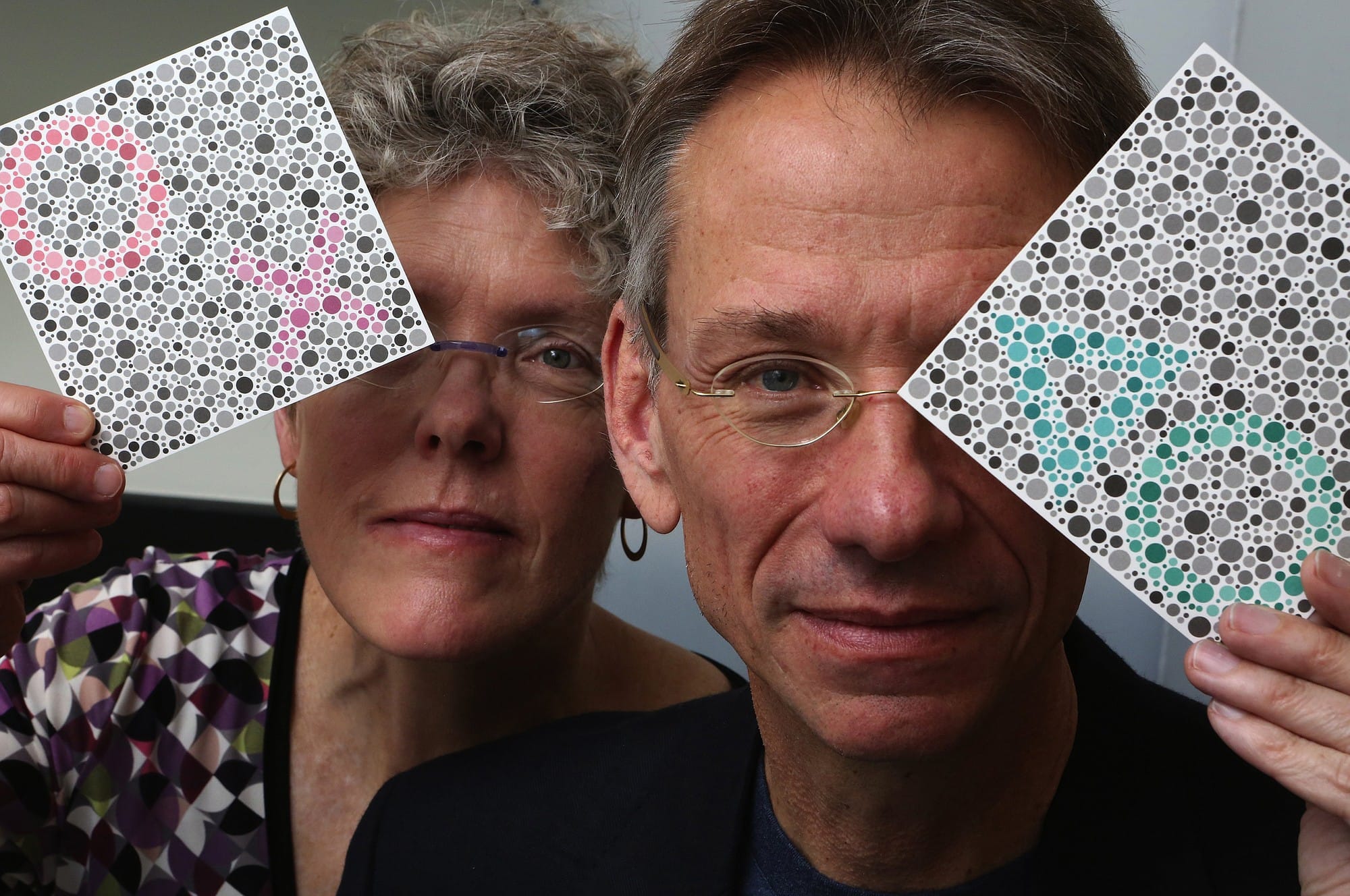SEATTLE — For the more than 10 million Americans with colorblindness, there’s never been a treatment, let alone a cure, for the condition that leaves them unable to distinguish certain hues.
Now, for the first time, two University of Washington professors have teamed with a California biotech firm to develop what they say may be a solution: a single shot in the eye that reveals the world in full color.
Jay and Maureen Neitz, husband-and-wife scientists who have studied the vision disorder for years, have arranged an exclusive license agreement between UW and Avalanche Biotechnologies of Menlo Park. Together, they’ve found a new way to deliver genes that can replace missing color-producing proteins in certain cells, called cones, in the eyes.
“I don’t think there’s any question that it will work,” said Maureen Neitz, 57, a UW professor of ophthalmology.
The new treatment — which may be tested in humans within two years — could be a boon for the 1 in 12 men and 1 in 230 women with color-vision deficiency.
The trouble occurs when people are born without one or more of the three types of color-sensing proteins normally present in the cones of the retina. The most common type is red-green colorblindness, followed by blue-yellow colorblindness. A very small proportion of the population is completely colorblind, seeing only shades of gray.
Because they can’t perceive certain colors, they see hues in muted or different shades than people with normal vision.
Brian Chandler, 38, of Seattle, said he first noticed he was colorblind in seventh grade, when he started getting C’s and D’s on drawings in science class.
“I was coloring green stuff brown and brown stuff green,” recalled Chandler, a traffic-safety engineer.
Colorblindness is often a genetic disorder. It affects mostly men, who can inherit a mutation on the X chromosome that impairs their perception of red and green. A much smaller fraction of cases are in women, who have two X chromosomes, which gives them a better chance of avoiding effects of any genetic defect.
Most people think of colorblindness as an inconvenience or mild disability, mainly causing problems with unmatched shirts and socks. But the Neitzes say the condition can have profound impacts — limiting choices for education or careers, making driving dangerous, and forcing continual adaptation to a world geared for color vision.
“There are an awful lot of people who feel like their life is ruined because they don’t see color,” said Jay Neitz, 61, the professor of ophthalmology who confirmed in 1989 that dogs are colorblind, too.
People may not qualify as commercial pilots, for instance, if they’re colorblind. Other careers that can be limited include those of chefs, decorators, electricians and house painters, all of which require detailed color vision.
The Neitzes have focused on the disorder for years, first proving in 2009 they could use gene therapy to correct colorblindness in male squirrel monkeys, which are born unable to distinguish between red and green.
In the journal Nature, they reported the success of a technique that inserted the human form of a gene that detects red color into a viral shell, and then injected it behind the retinas of two squirrel monkeys.
The monkeys, named Sam and Dalton, had been trained to recognize colors on a computer screen in exchange for a reward of grape juice. Before the surgery, they couldn’t detect certain hues, while after the procedure they got them right nearly every time.
But that technique is risky, requiring surgery, so the Neitzes were looking for another way to do the job.
“For 10 years, we have been trying to figure out a way to get the genes to go to the back of the eye with a simple shot,” said Neitz.
Now, with the help of Avalanche, the researchers say they’ve developed a technique that does just that. It uses a safe vector, called an adeno-associated virus, to house the pigment gene, which is injected directly into the vitreous, the jellylike center of the eye. Once, there, it targets cells on the back of the retina, said Thomas W. Chalberg Jr., the co-founder and chief executive of the firm.
“It’s a protein shell, kind of like a Trojan horse, that gets you entry into the cell. Once you’re there, the DNA gets to set up shop and produce the photo pigment of interest,” he said. Avalanche has two drug candidates, AVA-322 and AVA-323, that carry pigment-producing genes.
It takes only 30 percent of the cells to be transduced, or changed, to put the world in a whole new hue, Jay Neitz said. Early tests show the technique meets that mark in monkeys.
After preclinical trials are complete, Chalberg said he hopes to move to human trials within one to two years and then seek federal Food and Drug Administration approval for the treatment. Eventually, the treatment could be offered during a single visit to an opthalmologist’s office.
Such a development would be “an amazing advantage,” said Dr. Rohit Varma, a professor of ophthalmology and director of the Eye Institute at the University of Southern California, who is not involved in the research.
“It would cure or at least help people who are colorblind,” he said. “This is the first hope, in many ways, for these individuals that suffer from this.”
While noting that many tests that succeeded in animals have later failed in humans, he said he’s cautiously optimistic that the trials will deliver as promised. Plus, he said, it will be important to learn whether the therapy not only adds the color-sensing ability, but actually improves the lives of those who are treated.



